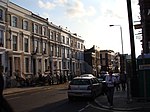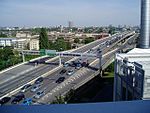105–123 St Mark's Road
1979 in LondonGrade II listed houses in the Royal Borough of Kensington and ChelseaHouses completed in 1979London building and structure stubsNorth Kensington ... and 1 more
Postmodern architecture in the United Kingdom
105–123 St Mark's Road in the London Borough of Kensington, are Grade II listed houses with Historic England. They were built between 1977 and 1979 and designed by Jeremy and Fenella Dixon.
Excerpt from the Wikipedia article 105–123 St Mark's Road (License: CC BY-SA 3.0, Authors).105–123 St Mark's Road
St Mark's Road, London North Kensington (Royal Borough of Kensington and Chelsea)
Geographical coordinates (GPS) Address Nearby Places Show on map
Geographical coordinates (GPS)
| Latitude | Longitude |
|---|---|
| N 51.51962 ° | E -0.21795 ° |
Address
St Mark's Road 105-123
W10 6NN London, North Kensington (Royal Borough of Kensington and Chelsea)
England, United Kingdom
Open on Google Maps





